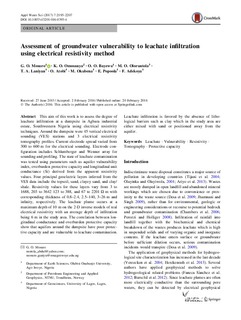| dc.contributor.author | Mosuro, Ganiyu | |
| dc.contributor.author | Omosanya, Kamaldeen Olakunle | |
| dc.contributor.author | Bayewu, O.O | |
| dc.contributor.author | Oloruntola, M.O | |
| dc.contributor.author | Laniyan, T.A | |
| dc.date.accessioned | 2020-02-28T11:47:12Z | |
| dc.date.available | 2020-02-28T11:47:12Z | |
| dc.date.created | 2016-02-24T09:51:26Z | |
| dc.date.issued | 2016 | |
| dc.identifier.citation | Applied water science. 2016, 1-13. | nb_NO |
| dc.identifier.issn | 2190-5487 | |
| dc.identifier.uri | http://hdl.handle.net/11250/2644351 | |
| dc.description.abstract | This aim of this work is to assess the degree of leachate infiltration at a dumpsite in Agbara industrial estate, Southwestern Nigeria using electrical resistivity techniques. Around the dumpsite were 45 vertical electrical sounding (VES) stations and 3 electrical resistivity tomography profiles. Current electrode spread varied from 300 to 600 m for the electrical sounding. Electrode configuration includes Schlumberger and Wenner array for sounding and profiling. The state of leachate contamination was tested using parameters such as aquifer vulnerability index, overburden protective capacity and longitudinal unit conductance (Si) derived from the apparent resistivity values. Four principal geoelectric layers inferred from the VES data include the topsoil, sand, clayey sand, and clay/shale. Resistivity values for these layers vary from 3 to 1688, 203 to 3642 123 to 388, and 67 to 2201 Ω m with corresponding thickness of 0.8–2.4, 2.5–140, 3–26 m and infinity, respectively. The leachate plume occurs at a maximum depth of 10 m on the 2-D inverse models of real electrical resistivity with an average depth of infiltration being 6 m in the study area. The correlation between longitudinal conductance and overburden protective capacity show that aquifers around the dumpsite have poor protective capacity and are vulnerable to leachate contamination. Leachate infiltration is favored by the absence of lithological barriers such as clay which in the study area are either mixed with sand or positioned away from the aquifer. | nb_NO |
| dc.language.iso | eng | nb_NO |
| dc.publisher | Springer Nature | nb_NO |
| dc.rights | Navngivelse 4.0 Internasjonal | * |
| dc.rights.uri | http://creativecommons.org/licenses/by/4.0/deed.no | * |
| dc.title | Assessment of groundwater vulnerability to leachate infiltration using electrical resistivity method | nb_NO |
| dc.type | Journal article | nb_NO |
| dc.type | Peer reviewed | nb_NO |
| dc.description.version | publishedVersion | nb_NO |
| dc.source.pagenumber | 1-13 | nb_NO |
| dc.source.journal | Applied water science | nb_NO |
| dc.identifier.doi | 10.1007/s13201-016-0393-4 | |
| dc.identifier.cristin | 1339483 | |
| dc.description.localcode | Open Access This article is distributed under the terms of the Creative Commons Attribution 4.0 International License (http://creativecommons.org/licenses/by/4.0/), which permits unrestricted use, distribution, and reproduction in any medium, provided you give appropriate credit to the original author(s) and the source, provide a link to the Creative Commons license, and indicate if changes were made. | nb_NO |
| cristin.unitcode | 194,64,90,0 | |
| cristin.unitname | Institutt for geovitenskap og petroleum | |
| cristin.ispublished | true | |
| cristin.fulltext | original | |
| cristin.qualitycode | 1 | |

